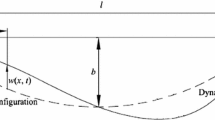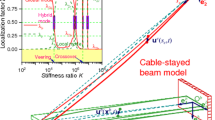Abstract
This paper is devoted to cable–flexible support coupled nonlinear vibrations using a asymptotic boundary modulation technique. Asymptotic/reduced cable–support coupled nonlinear models are established first using the boundary modulation concept, after a proper scaling analysis at the cable–support interface. The cable and the support turn out to be coupled through cable-induced and support-induced boundary modulations in a rational way, which are derived analytically by asymptotic approximations and multiple scale expansions. Based upon the reduced models, two prototypical kinds of cable–support coupled dynamics are fully investigated, i.e., one with the support excited and the other with the cable excited. Essentially, they correspond to refined versions of two typical degenerate cable dynamics, i.e., cables excited externally with fixed supports and cables excited by ideal moving supports. Applying numerical continuation algorithms to the reduced models, cable–support typical coupled frequency response diagrams are constructed, with their stabilities, bifurcation characteristics, and the coupling’s effects on the cable determined. All these approximate analytical results are verified by the numerical results from the original full cable–support system using the finite difference method.




















Similar content being viewed by others
References
Rega, G.: Nonlinear vibrations of suspended cables, part I: modeling and analysis. Appl. Mech. Rev. 57, 443–478 (2004)
Ibrahim, R.A.: Nonlinear vibrations of suspended cables–Part III: Random excitation and interaction with fluid flow. Appl. Mech. Rev. 57, 515–549 (2005)
Rega, G., Alaggio, R.: Spatio-temporal dimensionality in the overall complex dynamics of an experimental cable/mass system. Int. J Solids Struct. 38, 2049–2068 (2001)
Rega, G., Alaggio, R.: Experimental unfolding of the nonlinear dynamics of a cable-mass suspended system around a divergence-Hopf bifurcation. J. Sound Vib. 322, 581–611 (2009)
Irvine, H.M., Caughey, T.K.: The linear theory of free vibrations of a suspended cable. Proc R Soc Londn A 341, 299–315 (1974)
Irvine, H.M.: Cable Structures. The MIT Press, Cambridge (1981)
Triantafyllou, M.S.: Dynamics of cables, towing cables, and mooring systems. Shock Vib. Dig. 23, 3–8 (1991)
Hagedorn, P., Schafer, B.: On non-linear free vibration of an elastic cables. Int. J. Non-Linear Mech. 15, 333–339 (1980)
Luongo, A., Rega, G., Vestroni, F.: Planar non-linear free vibrations of an elastic cable. Int. J. Non-Linear Mech. 19, 39–52 (1984)
Benedettini, F., Rega, G.: Non-linear dynamics of an elastic cable under planar excitation. Int. J. Non-Linear Mech. 22, 497–509 (1987)
Benedettini, F., Rega, G., Vestroni, F.: Modal coupling in the free nonplanar finite motion of an elastic cable. Meccanica 21, 38–46 (1986)
Rao, G.V., Iyengar, R.N.: Internal resonance and non-linear response of a cable under periodic excitation. J. Sound Vib. 149, 25–41 (1991)
Perkins, N.C.: Modal interactions in the non-linear response of elastic cables under parametric/external excitation. Int. J. Non-Linear Mech. 27, 233–250 (1992)
Srinil, N., Rega, G., Chucheepsakul, S.: Two-to-one resonant multi-modal dynamics of horizontal/inclined cables. Part I. Nonlinear Dyn. 48, 231–252 (2007)
Pakdemirli, M., Nayfeh, S.A., Nayfeh, A.H.: Analysis of one-to-one autoparametric resonances in cables: discretization versus direct treatment. Nonlinear Dyn. 8, 65–83 (1995)
Rega, G., Lacarbonara, W., Nayfeh, A.H., Chin, C.M.: Multiple resonances in suspended cables: direct versus reduced-order models. Int. J. Non-Linear Mech. 34, 901–924 (1999)
Nayfeh, A.H., Arafat, A.H., Chin, C.M., Lacarbonara, W.: Multimode interactions in suspended cables. J. Vib. Control 8, 337–387 (2002)
Zhao, Y.Y., Wang, L.H., Chen, D.L., Jiang, L.Z.: Nonlinear dynamic analysis of the two-dimensional simplified model of an elastic cable. J. Sound Vib. 255, 43–59 (2002)
Lacarbonara, W., Rega, G., Nayfeh, A.H.: Resonant non-linear normal modes. Part I: analytical treatment for structural one dimensional systems. Int. J. Non-Linear Mech. 38, 851–871 (2003)
Zhao, Y.Y., Wang, L.H.: On the symmetric modal interaction of the suspended cable: Three-to-one internal resonance. J. Sound Vib. 294, 1073–1093 (2006)
Nayfeh, A.H.: Non-linear Interact. Wiley-Inter science, New York (2000)
Benedettini, F., Rega, G., Alaggio, R.: Non-linear oscillations of a four-degree-of-freedom model of a suspended cable under multiple internal resonance conditions. J. Sound Vib. 182, 775–798 (1995)
Cai, Y., Chen, S.S.: Dynamics of elastic cable under parametric and external resonances. J. Eng. Mech. 120, 1786–1802 (1993)
Lilien, J.L., PintodaCosta, A.: Vibration amplitudes caused by parametric excitation of cable stayed structure. J. Sound Vib. 174, 69–90 (1994)
Pintoda Costa, A., Martins, J.A., Branco, F., Lilien, J.L.: Oscillations of bridge stay cables induced by periodic motions of deck and/or towers. J. Eng. Mech. 122, 613–622 (1996)
Berlioz, A., Lamarque, C.H.: A non-linear model for the dynamics of an inclined cable. J. Sound Vib. 279, 619–639 (2005)
Georgakis, C.T., Taylor, C.A.: Nonlinear dynamics of cable stays. Part 1: sinusoidal cable support excitation. J. Sound Vib. 281, 537–564 (2005)
Wang, L.H., Zhao, Y.Y.: Large amplitude motion mechanism and non-planar vibration character of stay cables subject to the support motions. J. Sound Vib. 327, 121–133 (2009)
Gonzalez-Buelga, A., Neild, S.A., Wagg, D.J., Macdonald, J.H.G.: Modal stability of inclined cables subjected to vertical support excitation. J. Sound Vib. 318, 565–579 (2008)
Macdonald, J.H.G., Dietz, M.S., Neild, S.A., Gonzalez-Buelga, A., Crewe, A.J., Wagg, D.J.: Generalized modal stability of inclined cables subjected to support excitations. J. Sound Vib. 329, 4515–4533 (2010)
Luongo, A., Zulli, D.: Dynamic instability of inclined cables under combined wind flow and support motion. Nonlinear Dyn. 67, 71–87 (2012)
Chen, H., Zuo, D., Zhang, Z., Xu, Q.: Bifurcations and chaotic dynamics in suspended cables under simultaneous parametric and external excitations. Nonlinear Dyn. 62, 623–646 (2010)
Zulli, D., Luongo, A.: Nonlinear Energy Sink to control vibrations of an internally nonresonant elastic string. Meccanica 50, 781–794 (2015)
Rega, G., Luongo, A.: Natural vibrations of suspended cables with flexible supports. Comput. Struct. 12, 65–75 (1980)
Warnitchaia, P., Fujinob, Y., Susumpowc, T.: A non-linear dynamic model for cables and its application to cable-structure system. J. Sound Vib. 187, 695–712 (1995)
Gattulli, V., Morandini, M., Paolone, A.: A parametric analytical model for non-linear dynamics in cable-stayed beam. Earthq. Eng. Struct. Dyn. 31(6), 1281–1300 (2002)
Caetano, E., Cunha, A., Taylor, C.A.: Investigation of dynamic cable-deck interaction in a physical model of a cable-stayed bridge. Part II: Seismic response. Earthq. Eng. Struct. Dyn. 29(4), 499–521 (2000)
Li, H.N., Shi, W.L., Guo, X.W., Lian, G.J.: Simplified models and experimental verification for coupled transmission tower-line system to seismic excitations. J. Sound Vib. 286, 569–585 (2005)
Caetano, E., Cunha, A., Gattulli, V., Lepidi, M.: Cable-deck dynamic interactions at the International Guadiana Bridge: On-site measurements and finite element modelling. Struct. Control Health Monit. 15(3), 237–264 (2008)
Guo, T.D., Kang, H.J., Wang, L.H., Zhao, Y.Y.: Cable’s mode interactions under vertical support motions: boundary resonant modulation. Nonlinear Dyn. 84(3), 1259–1279 (2016). doi:10.1007/s11071-015-2565-4
Hagedorn, P., DasGupta, A.: Vibrations and Waves in Continuous Mechanical Systems. Wiley, Chichester (2007)
Nayfeh, A.H., Balachandran, B.: Applied Nonlinear Dynamics. Wiley, New York (1994)
Ermentrout B.: Simulating, Analyzing, and Animating Dynamical Systems-A Guide to XPP-AUTO for Researchers and Students. SIAM, Philadelphia (2002)
Doedel E.: Lecture Notes on Numerical Analysis of Nonlinear Equations. Last Modified (2010)
Acknowledgements
The authors appreciate all the efforts from Prof. Rega, Sapienza University of Rome, Italy, for the valuable discussions and constructive suggestions. This study is funded by National Science Foundation of China under Grant Nos 11502076 and No. 11572117, and Program for Supporting Young Investigators, Hunan University.
Author information
Authors and Affiliations
Corresponding author
Appendices
Appendix 1
Suspended cable’s linear modal analysis can be found in reference [5]. We restrict our attention to cable’s in-plane symmetric modes in this paper, and these modes are given by
where \(c_{\mathrm{{i}}}\) is the normalization constants. And the associated eigenfrequencies are determined by
where \(\lambda ^{2}=EA/mgl(8b/l)^{3 }\) is the elasto-geometric parameter. The above nonlinear transcendental equations can be solved by the Newton–Raphson method.
The linear and nonlinear operators in cable’s dynamic equations, i.e., Eq. (11), are defined as
The cubic nonlinear terms in Eq. (15) are defined as
Appendix 2
The second-order shape functions in Eq. (19), Eq. (51), and Eq. (55) are illustrated in Fig. 21. They are governed by the following boundary value problem (BVP)
with boundary conditions \(\varPsi _{\mathrm{{k}}}(0)= \varPsi _{k}(1)=0\), \(k=1,2\).
Appendix 3
To validate our reduced models, numerical full/discrete cable–support coupled models are derived by using the finite difference method. Briefly, using the second-order finite difference scheme,
The cable dynamics in Eq. (1) is discretized as
and the support dynamics in Eq. (3) is discretized as

where \(\Delta x\), \(\Delta t\) are space/time steps, and \(x_i =i\Delta x,\;t_j =j \Delta t\) are the discrete grids for time marching. The distributed excitation amplitude \(F_c \) (in physics space) is related to the modal excitation amplitude in Eq. (41) by \(f_c =\left\langle {F_c \left( x \right) ,\phi _n } \right\rangle \).
The integral term in the cable equation (64), i.e., S, is obtained by the Simpson’s integral rule
The support-induced boundary excitation, i.e., Eq. (2), is discretized as
and the dynamic tension \(T_\mathrm{{d}} \left( {t_j } \right) \) in Eq. (65) is calculated by
We split the cable into 1000 segments, i.e., the space step \(\Delta x=0.001\), and set the time step \(\Delta t=0.0001(2)\). Based upon this discrete model, we use a time-stepping program coded by C++ to simulate the dynamic responses of cable–support coupled system directly. After the cable–support coupled steady responses are obtained, we compare these numerical results from the numerical full model to the approximate analytical ones.
Rights and permissions
About this article
Cite this article
Guo, T., Kang, H., Wang, L. et al. An asymptotic expansion of cable–flexible support coupled nonlinear vibrations using boundary modulations. Nonlinear Dyn 88, 33–59 (2017). https://doi.org/10.1007/s11071-016-3229-8
Received:
Accepted:
Published:
Issue Date:
DOI: https://doi.org/10.1007/s11071-016-3229-8





